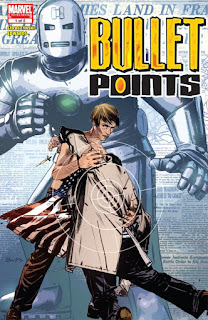 The 2007 series Bullet Points, while squarely falling into the category of a What If tale, has the advantage of being presented as a five-issue limited series, allowing it to take its time as it makes its way through four decades of Marvel history--a method of presentation which avoids cramming a dizzying number of alternate events into one issue and, in the process, reducing their impact on the reader. The story is definitely a notch or two above the typical What If tales that were released in the late '70s and '80s; yet while there is no Watcher who narrates the story and guides us through this book's startling developments, you'll find that it eventually takes on the same characteristics of its predecessors by the time it reaches its conclusion, as it suddenly turns to make its climax a spectacle of elements that had, up to that point, been so carefully and sensibly presented. That said, the bulk of its story is an enjoyable and thought-provoking read that is so well-handled in both story and art that it's a pleasure to simply take your time with it and allow it to do what most stories strive to accomplish: to hold your attention and make you feel for its characters.
The 2007 series Bullet Points, while squarely falling into the category of a What If tale, has the advantage of being presented as a five-issue limited series, allowing it to take its time as it makes its way through four decades of Marvel history--a method of presentation which avoids cramming a dizzying number of alternate events into one issue and, in the process, reducing their impact on the reader. The story is definitely a notch or two above the typical What If tales that were released in the late '70s and '80s; yet while there is no Watcher who narrates the story and guides us through this book's startling developments, you'll find that it eventually takes on the same characteristics of its predecessors by the time it reaches its conclusion, as it suddenly turns to make its climax a spectacle of elements that had, up to that point, been so carefully and sensibly presented. That said, the bulk of its story is an enjoyable and thought-provoking read that is so well-handled in both story and art that it's a pleasure to simply take your time with it and allow it to do what most stories strive to accomplish: to hold your attention and make you feel for its characters.Written by J. Michael Straczynski with art by Tommy Lee Edwards, Bullet Points follows the lives of four individuals--Steve Rogers, Reed Richards, and Peter Parker, and, to a certain extent, Bruce Banner--whose histories are radically different from what seasoned readers may be familiar with, all due to a single incident from the past. As for the series' unusual title, it's understandable if your first thought is of the bullet points commonly used in documents to list key points of a subject or discussion, followed by finding yourself perplexed as to how that relates to a comic book story. Instead, Straczynski uses the deadly efficiency of a bullet striking its target as a lead-in to illustrate how bullets--in some cases a single bullet--have been used throughout human history to cause death as well as change, with many of those deaths leading to unexpected historical consequences.
For instance, there likely aren't too many people familiar with Captain America who are unaware of Project: Rebirth and Abraham Erskine's assassination by a Nazi agent, thereby causing Steve Rogers to be the only person to receive Erskine's super-soldier serum. That agent fired a number of bullets in that hidden chamber that day--but Straczynski needs only one to make his, er, point.
It's Erskine's death--or, rather, the date of Erskine's death--that becomes this story's point of divergence from actual events in our reality and thus sets the tone for what's to come. As for how the plot ties into the series title's origin, the association with the bullet points of a document seems intentional, perhaps as a hook of some sort that takes advantage of the phrase's familiarity--though Edwards' graphic of a slumped body in someone's crosshairs on the first issue's cover, as well as what appears to be a gunshot impact in the masthead, completes the picture well enough.
Soon enough, it becomes clear that Erskine meets his death just as he did in the original story. But this time, he'll have company.
Continued »»»
